|
Review
CH Products Throttle Quadrant USB
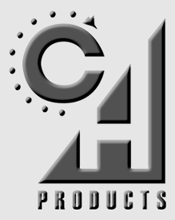 CH
Products has added an interesting new unit to their list of
legendary game controllers. The CH
Throttle Quadrant USB.
It's definitely a unique and interesting piece of equipment,
but to be totally honest my first impression was somewhat
less than enthusiastic. It appears to be typical CH Hardware…
well engineered and manufactured, but my initial feeling was
that it's something only useful to the 'Civilian Aviation
and Virtual Airlines' gaming crowd. 'Everybody' knows the
real fun is in the air combat sims! After all, I make my living
flying Jumbo Jets, That's work! I only do it for the money!
(Big Lie! It's the SECOND best job in the world). This new
CH controller has six funny levers on it… who the heck
needs more than one throttle (Well… Maybe TWO, if you
are an F-4, F-14, F-15, F-18 or P-38 JOCK!). Worse yet, it's
not a 'real' HOTAS! There aren't any four/eight way hats,
rotaries, or buttons on ANY of throttle levers! The
ONLY switches, actually buttons, are on the front of the quadrant!
How could this thing possibly be of any real use to the dedicated
virtual combat pilot? CH
Products has added an interesting new unit to their list of
legendary game controllers. The CH
Throttle Quadrant USB.
It's definitely a unique and interesting piece of equipment,
but to be totally honest my first impression was somewhat
less than enthusiastic. It appears to be typical CH Hardware…
well engineered and manufactured, but my initial feeling was
that it's something only useful to the 'Civilian Aviation
and Virtual Airlines' gaming crowd. 'Everybody' knows the
real fun is in the air combat sims! After all, I make my living
flying Jumbo Jets, That's work! I only do it for the money!
(Big Lie! It's the SECOND best job in the world). This new
CH controller has six funny levers on it… who the heck
needs more than one throttle (Well… Maybe TWO, if you
are an F-4, F-14, F-15, F-18 or P-38 JOCK!). Worse yet, it's
not a 'real' HOTAS! There aren't any four/eight way hats,
rotaries, or buttons on ANY of throttle levers! The
ONLY switches, actually buttons, are on the front of the quadrant!
How could this thing possibly be of any real use to the dedicated
virtual combat pilot?
I'll
bet you think I don't care for the CH TQ… Nothing could
be farther from the truth. Lets see why…
Inventory
and Setup
Utilitarian is the best word to describe
the contents of the box… in it I found the CH TQ unit,
screw-on desk mounts, and a set of extra throttle lever knobs.
There are a total of four black 'Throttle' knobs, two blue
'Prop' knobs, and two red 'Mixture' knobs. Noticeably missing
are a complex printed manual and driver/installation CD. I
strongly agree with the decision 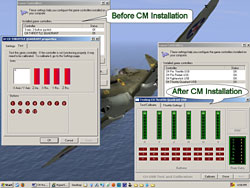 NOT
in include these last two items. Every time I purchase just
about ANY PC hardware, gaming or not, the included drivers
tend to be woefully out of date and the printed manuals inadequate.
I always end up on the manufactures web site downloading current
ones. Why waste the time and cost to include them? NOT
in include these last two items. Every time I purchase just
about ANY PC hardware, gaming or not, the included drivers
tend to be woefully out of date and the printed manuals inadequate.
I always end up on the manufactures web site downloading current
ones. Why waste the time and cost to include them?
The TQ's setup in Windows XP was painless…
Plug it in and XP recognizes it as a 'CH Throttle Quadrant',
a six-axis, 12-button controller. Separate drivers are not
really necessary to use the TQ as a basic throttle controller.
Be advised that I only tested the CH TQ in Windows XP. I no
longer have any of my machines running Windows 98SE, so I
am not sure if the TQ would behave as well in that legacy
OS. This basic six-axis controller mode is really an easy
way to use the TQ if your game allows assignment of axis and
buttons organically. If your favorite game cannot accommodate
that, or you want to get more creative with control assignments
then you have another option.  That
is to download and Install CH Product's Control Manger Software.
It enables extended programmability and the ability to combine
newer CH USB Controllers into a single 'virtual' controller.
With Control Manager (CM) installed, the TQ will be recognized
as a six-axis, 24 button controller. The latest version of
CM is available on the CH web site. That
is to download and Install CH Product's Control Manger Software.
It enables extended programmability and the ability to combine
newer CH USB Controllers into a single 'virtual' controller.
With Control Manager (CM) installed, the TQ will be recognized
as a six-axis, 24 button controller. The latest version of
CM is available on the CH web site.
When installing Control Manager...
I HIGHLY recommend taking the time to actually READ all those
little instructional pop-ups that we normally ignore during
software installation. This will prevent errors in the setup
of your CH USB controller and the pain of trouble-shooting
driver issues later. Once CM is in and running I also recommend
you do the individual controller calibration routines; I've
found it can really make a difference in output accuracy and
eliminates some potential problems. I experienced a big difference
in the accuracy and reliability of the TQ's pseudo buttons
after proper calibration.
Go
To Page 2
CH Products Throttle Quadrant USB
Back to Page
1
Description and Function
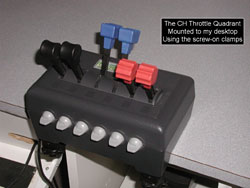 The
CH Throttle Quadrant is appropriately and very descriptively
named; it is a rectangular six-lever throttle quadrant with
six two-way spring centering switches on the facing side.
It clamps to a desk or table top with what appears to be the
same clamps as on CH Products 'Yoke' controllers. The throttle
knobs are interchangeable allowing several combinations of
colors and shapes among the throttle levers. Each Throttle
has two detents in the aft, or throttle closed, position.
The detents are the 'extra' 12, or pseudo buttons on the TQ.
The additional 12-pseudo buttons cannot be directly activated
without lever movement. As previously stated, Windows does
not recognize the additional buttons in the standard game
controller applet until Control Manager has been installed.
Once that's accomplished then Windows displays a six-axis,
24 button unit. The
CH Throttle Quadrant is appropriately and very descriptively
named; it is a rectangular six-lever throttle quadrant with
six two-way spring centering switches on the facing side.
It clamps to a desk or table top with what appears to be the
same clamps as on CH Products 'Yoke' controllers. The throttle
knobs are interchangeable allowing several combinations of
colors and shapes among the throttle levers. Each Throttle
has two detents in the aft, or throttle closed, position.
The detents are the 'extra' 12, or pseudo buttons on the TQ.
The additional 12-pseudo buttons cannot be directly activated
without lever movement. As previously stated, Windows does
not recognize the additional buttons in the standard game
controller applet until Control Manager has been installed.
Once that's accomplished then Windows displays a six-axis,
24 button unit.
Control Manager software allows you
to configure the throttle levers in several ways. The default
lever control assignment is as an axis (DirectX Mode). If
the game function you want to use a given lever for does not
allow axis assignments, then you have the choice of two different
ways to assign keystrokes in Programmed Function mode, they
are Up/Down or Positional.
The Up / Down function is used with
'increase' and 'decrease' keys. It has two zones, one above
and one below the detent, with a minimum of two positions
and a maximum of 100. There are also separate assignable detents
that are specific for each direction of lever movement…
i.e. increasing direction key assignments and decreasing direction
key assignments. The Positional mode has two sections, the
Min Zone Keys below the detent and the Normal Zone Keys above
the detent. The keys assigned here will activated in proportion
to the position of the lever.
The six two-position momentary switches
on the front of the TQ are programmed just like standard CH
controller switches/buttons using CM software. CM is very
intuitive and I am sure that it will satisfactorily fulfill
the needs of most users. For the really adventurous MAP makers
CH Products included a text based scripting utility called
CMS (Control Manager Scripting). It can write more complex
command algorithms when the CM GUI just won't do… I have
used CMS with other CH units. It is a very useful programming
utility, but it is defiantly more complex and will take some
time to learn.
The TQ in
Games: FS2004, CFS 3 and Pacific Fighters
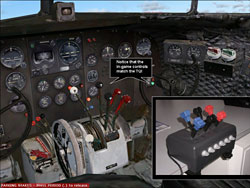 FS
2004 was initially selected due to its very realistic engine
control emulation and interface. It seemed the most appropriate
game to begin my evaluation. The TQ was added to my current
CH HOTAS FS 2004 Control Manager Map of Fighterstick, Pro
Throttle, and Pro Pedals. The process went quickly and was
easily accomplished. The only real limitation I had was running
out of available axes on a single controller; eight is the
maximum. Control Manager software provides a solution by allowing
the creation of another virtual controller (when the map is
'activated), and therefore an additional set of axes. The
only limitation is the ability of the intended game to recognize
and use multiple controllers. Most recent flight sims do have
this capability so it should not cause a problem in most situations.
FS 2004 does indeed recognize multiple controllers; in fact
it allows the assignment of three separate controls per engine
for up to four engines. If you assign each engine with a throttle,
prop, and mixture that's a total of 12 axes for engine control!
If you had a B-17 or B-24 add-on for FS2004 you would need
TWO… yes TWO CH TQ's for engine management alone! That's
a whole lot o' levers! "Everybody grab a throttle! We're
going around!" FS
2004 was initially selected due to its very realistic engine
control emulation and interface. It seemed the most appropriate
game to begin my evaluation. The TQ was added to my current
CH HOTAS FS 2004 Control Manager Map of Fighterstick, Pro
Throttle, and Pro Pedals. The process went quickly and was
easily accomplished. The only real limitation I had was running
out of available axes on a single controller; eight is the
maximum. Control Manager software provides a solution by allowing
the creation of another virtual controller (when the map is
'activated), and therefore an additional set of axes. The
only limitation is the ability of the intended game to recognize
and use multiple controllers. Most recent flight sims do have
this capability so it should not cause a problem in most situations.
FS 2004 does indeed recognize multiple controllers; in fact
it allows the assignment of three separate controls per engine
for up to four engines. If you assign each engine with a throttle,
prop, and mixture that's a total of 12 axes for engine control!
If you had a B-17 or B-24 add-on for FS2004 you would need
TWO… yes TWO CH TQ's for engine management alone! That's
a whole lot o' levers! "Everybody grab a throttle! We're
going around!"
Go
To Page 3
CH Products Throttle Quadrant USB
Back to Page
2
Once Control Manager was configured
and my FS 2004 Map downloaded I proceeded into FS 2004 to
configure the in-game assignments. This was more complicated
than it sounds… It had absolutely nothing to do with
the TQ... It is the complexity of FS 2004's control system.
To correctly configure FS 2004 you must pay close attention
to control axis assignments, sensitivities settings and dead
zone settings. The first few attempts to fly the DC-3 proved
frustrating until I noticed that the sensitivities and dead
zone settings for a few of my 'extra' axes were turned all
the way down. Once they were properly adjusted everything
worked flawlessly. It was really fascinating watching individual
in-game throttles, prop levers and mixture levers move proportional
to my inputs on the TQ… It really adds to the immersion
factor and feels almost eerie! Take a closer look at the screenshot
with the photo inset to get a better idea of what I mean.
This made flying that old FS 2004 DC-3 much more fun…
I may have to spend some more time with this 'boring' civilian
flight simulation! Lets move on to an 'action' flight sim
and see how the TQ handles that genre aviation gaming…
 Since
I already had the FS 2004 Map loaded and my installation of
Microsoft's Combat Flight Simulator 3 control assignments
are configured similarly, CFS 3 was the next logical challenge
for the TQ. I had to spend a little time locating and assigning
in-game engine controls to the correct axis settings, but
once completed the TQ performed flawlessly. It added another
layer of depth to this classic, sometimes under appreciated,
combat simulation. The ability to easily and accurately manipulate
complex engine controls in a true to life manner really does
add a level of immersion not easily duplicated! Once again,
I was fascinated just watching the in-game throttle, prop,
and mixture levers accurately move, directly replicating my
inputs on the TQ. (Yes its true… simple minds are easily
entertained!). I had a blast just flying around playing with
the engine controls… I am actually now considering purchasing
some of the add-on pay-ware titles for the MS flight sim series… Since
I already had the FS 2004 Map loaded and my installation of
Microsoft's Combat Flight Simulator 3 control assignments
are configured similarly, CFS 3 was the next logical challenge
for the TQ. I had to spend a little time locating and assigning
in-game engine controls to the correct axis settings, but
once completed the TQ performed flawlessly. It added another
layer of depth to this classic, sometimes under appreciated,
combat simulation. The ability to easily and accurately manipulate
complex engine controls in a true to life manner really does
add a level of immersion not easily duplicated! Once again,
I was fascinated just watching the in-game throttle, prop,
and mixture levers accurately move, directly replicating my
inputs on the TQ. (Yes its true… simple minds are easily
entertained!). I had a blast just flying around playing with
the engine controls… I am actually now considering purchasing
some of the add-on pay-ware titles for the MS flight sim series…
Oleg Maddox's Pacific Fighters is
one of my favorite games; I play it almost to the exclusion
of everything else. I really had high expectations for the
TQ in PF's multi-engine aircraft. Unfortunately I discovered
that PF has some limitations that restrict the accurate engine
control the TQ was designed for. Oleg's great flight sim lacks
the ability to assign different control axes to each engine
in multi-engine aircraft. There is only one engine and one
prop axis; additionally the mixture and supercharger can only
be controlled via keyboard commands. In multi-engine aircraft
you must select the engine to individually adjust, perform
the control input, and then reselect 'all engines'. This is
an awkward way to operate in a 'combat' situation. Even the
TQ's industry leading programmability cannot fully work around
this problem. The only real solution would be a PF patch to
allow separate axes assignments to individual engines and
their subordinate controls.
The single engine aircraft in PF were
a different story, the TQ once again proved to be a very useful
and realistic tool. I mounted the TQ alongside of my CH Pro
Throttle in a position that would be appropriate in a real
aircraft. I then configured my HOTAS in the following mode:
CH Pro Throttle slider as the throttle axis, the first TQ
lever as the prop axis, and the next TQ lever as the mixture
control via keyboard positional commands (Be advised this
was a pretty useless control assignment as the mixture control
in PF is NOT very realistically modeled on aircraft with auto-mixture).
This configuration allowed me to use complex engine controls
in a very realistic, natural, and intuitive manner. The unused
levers on the TQ were quickly assigned to other functions
like landing gear, hook, supercharger control, and tail wheel
lock. It just FEELS more correct to drop the hook with a throw
of a lever instead of a 'peck' on a keyboard! A noticeable
but minor distraction is caused by PF's heavy use of 'toggle'
controls instead of single discrete key assignments, occasionally
you end up 'out of sequence' with your control input. A simple
solution is available; just ensure that all your controls
are in the correct position prior to beginning the game.
Go
To Page 4
CH Products Throttle Quadrant USB
Back to Page
3
Conclusions and Recommendations
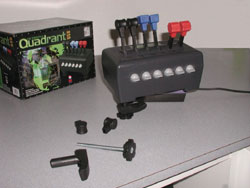 The
TQ is a very specialized game controller that is really only
appropriate for gamers who take their flight simulations seriously.
The casual player cannot justify the cost and does not need
this level of capability in entertainment hardware. For the
hard-core virtual pilot this unit can add significantly to
the gaming experience. I know it did for me. The addition
of the TQ to my CH HOTAS made a big difference in the feel
and immersion of all my flight sims. The difference is more
pronounced for civilian simulations with complex engine management
options than it is in the 'standard' combat sim, but it is
no less noticeable. If you're an aficionado of Microsoft Flight
Simulator and similar games, then the addition of the TQ to
your gaming hardware setup is blatantly obvious. You NEED
it... You'll LOVE it... and you'll USE it constantly. The
TQ is a very specialized game controller that is really only
appropriate for gamers who take their flight simulations seriously.
The casual player cannot justify the cost and does not need
this level of capability in entertainment hardware. For the
hard-core virtual pilot this unit can add significantly to
the gaming experience. I know it did for me. The addition
of the TQ to my CH HOTAS made a big difference in the feel
and immersion of all my flight sims. The difference is more
pronounced for civilian simulations with complex engine management
options than it is in the 'standard' combat sim, but it is
no less noticeable. If you're an aficionado of Microsoft Flight
Simulator and similar games, then the addition of the TQ to
your gaming hardware setup is blatantly obvious. You NEED
it... You'll LOVE it... and you'll USE it constantly.
The real purchase dilemma emerges
if you primarily enjoy 'flying' Air Combat games. The big
drawback of the TQ is its lack of on-throttle HOTAS buttons;
this does indeed limit its utility as a primary throttle control
in complex combat sims. I'm sure the TQ was targeted for the
civilian type flight simulations, but don't discount its use
in the 'hostile skies' of a combat sim. I was very surprised
how useful it is even in games with limited engine management
capability. I used it for secondary controls like gear, tail
hook, supercharger, and other things that would be controlled
by some sort of lever in real life. Is this secondary use
worth the significant cost of a TQ? I think so… The additional
immersion factor is hard to quantify, but I like it. As games
get more complex and realistic the need for more capable and
complex hardware in our HOTAS configurations will emerge.
The TQ fills that emerging need perfectly. After the experience
of this review I now 'need' the TQ in my HOTAS setup, and
I am even seriously considering purchasing a second TQ unit!
The list price for the TQ is impressive
at $200.00 US, but as I have stated before, you generally
get what you pay for. This has been especially true of CH
Products hardware. The quality and durability CH Products
controllers demonstrate is legendary — My original CH
gameport HOTAS is STILL in use after many years of problem
free operation! I can't make that claim with any other joystick
or HOTAS I've ever owned… and I have literally owned
all the major brands! The CH Throttle Quadrant is a great
addition to any serious flight sim enthusiast's hardware inventory.
If you think you want acquire one... good news! The street
price should be significantly lower than suggested retail.
Do a bit of looking on the Internet, it should be pretty easy
to locate. I found it for $133.00 US, not cheap but a fair
price for an outstanding piece of hardware.
CH Products Throttle Quadrant Summary
Assets:
- Six Axis, 12 or 24 button USB Throttle
controller
- Fully Programmable with Control
Manger Software (350 total Button positions)
- Can be combined with other CH USB
Controllers in a HOTAS
- Realistic appearance with changeable
knobs
- Easy installation and Setup
- Compatible with Windows 98, ME,
2000, and XP
- CH Products Quality and 2 year
warranty
- Outstanding Company Support
Liabilities:
Just a note to anticipate some
of the emails I generally get concerning "Exactly where
did you find it for that price?" If you are looking for
somewhere to purchase CH gear for a fair price, a good place
to start is Provantage computer supply in North Canton Ohio.
Take a look here.
They have pretty good prices on all controllers and CH Products
in particular. This is not an official SimHQ endorsement of
Provantage, but I personally had very good service from them.
As always…'Caveat Emptor'
Download a pdf of this
article here
(x kb).We want your Feedback.
Please let us know
what you thought of this article here.
System Specs
- AMD
Athlon 3000+ processor
- MachSpeed
N2PAP-Lite motherboard with onboard Aureal AC97 sound
- PNY Technologies Verto GeForce
FX 5950 Ultra
- 1GB
Kingston PC2700 DDR DRAM
- Creative
12x CD-ROM
- Maxtor
40GB main drive
- DirectX Version 9.0a
- Windows
2000 with SP4
Go
To Page 2
Click
here to go to top of this page.
Copyright 2008, SimHQ.com. All Rights Reserved. Contact the webmaster.
|

